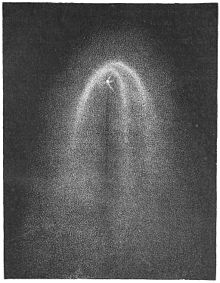|
C/1881 K1 (Tebbutt)
C/1881 K1, also called the Great Comet of 1881, Comet Tebbutt, 1881 III, and 1881b, is a non-periodic comet discovered by Australian amateur astronomer John Tebbutt on 22 May 1881 at Windsor, New South Wales.[4] It is called a great comet because of its brightness at its last apparition.[5] ObservationsOn 1 June, Tebbutt found the length of the tail to be 8° 38′. The comet was observed in the southern hemisphere from its discovery to 11 June; it then became visible in the night sky of the northern hemisphere by June 22 as a spectacular object to the naked eye.[6] On June 25 the tail's length was about 25° and the brightness of the nucleus was magnitude 1.[7][8][9] The comet was still visible to the naked eye in August but by the end of the month the tail was not discernible.[7] In the Alps, at an altitude of between 1,000 and 2,000 meters, Camille Flammarion observed the comet until the beginning of September.[10] The last successful telescope observation of the comet was on 15 February 1882.[7] For Tebbutt's Comet of 1881, Henry Draper took the first wide-angle photograph of a comet's tail and the first spectrum of a comet's head.[11] Andrew Common used his Newtonian reflecting telescope with 36-inch mirror to photograph the comet. Tebbutt’s account In his Astronomical Memoirs in the section entitled 1881, John Tebbutt gave an account of his discovery:[12]
References
External linksWikimedia Commons has media related to C/1881 K1. |
||||||||||||||||||||||||||||||||||||||||||||||||||


